Best Time of Year for Surf Fishing San Diego
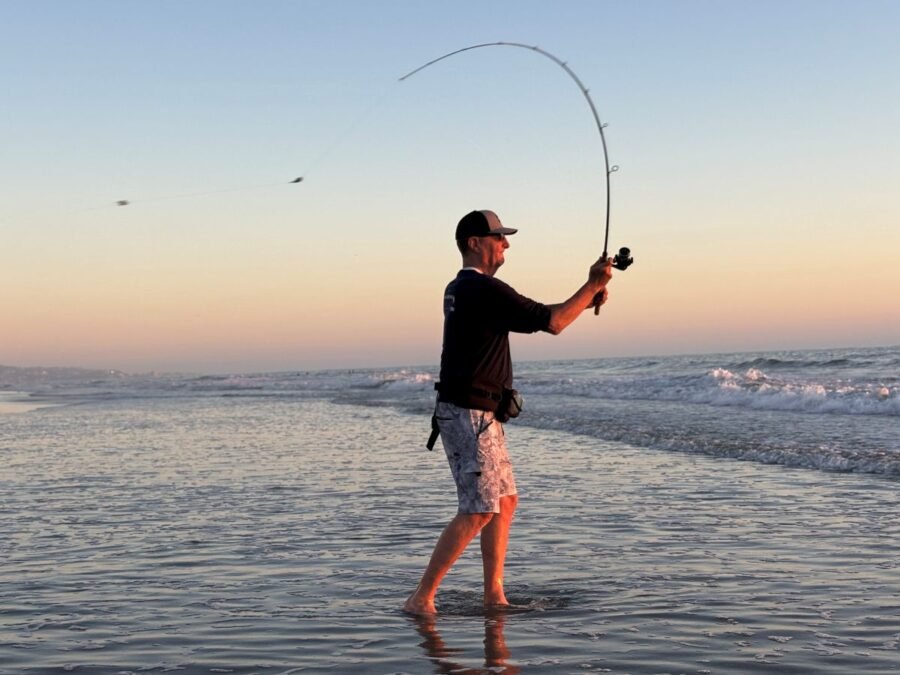
Back in 2018 and 2019, I (like many anglers) kept track of every fish I caught from the surf and made intricate and detailed logs of conditions throughout each session. In recent years, I’ve gotten a little lazy with fishing logs and rely on my gut and memory for most of what I do. But i stumbled across these charts recently and I think the data would be found to be valuable by many local anglers. These charts clearly illustrate what time of year is best for surf fishing in San Diego in general, as well as per species.
The fishing in July was absolutely epic! Fish were biting left and right and the larger species were hitting well (especially during those first couple weeks. If you’ve been out recently, you’ve probably noticed the bite has slowed. Continue reading below to see what I think is going to happen next.
Before we get into the charts, here’s a quick table on the general breakdown.
Peak Season for Surf Fishing in So Cal
| Species | Peak Season | General Season |
| California Corbina | Jun-Aug | Apr-Oct |
| Yellowfin Croaker | Jun-Aug | Apr-Oct |
| Spotfin Croaker | Jun-Aug | Apr-Oct |
| Barred Surf Perch | Feb-May | Year Round |
| Walleye Surf Perch | Feb-May | Year Round |
| Shovelnose Guitar Fish | Jun-Aug | Apr-Oct |
| Sting Ray | Jun-Aug | Year Round |
| Bat Ray | Jun-Aug | Year Round |
| Leopard Shark | May-Aug | Apr-Oct |
| California Halibut | Jan-May | Year Round |
| Soupfin Shark | Mar-Oct | Year Round |
The two charts below are from 2018 and show (first) the total number of fish caught per any given session and (second) the number of catches per species per session. As we can see here, the best time of year for surf fishing in 2018 began the first week of June. It then ended as we rolled into October. You could say it slowed a bit after the middle of August but it was still fairly productive through September.
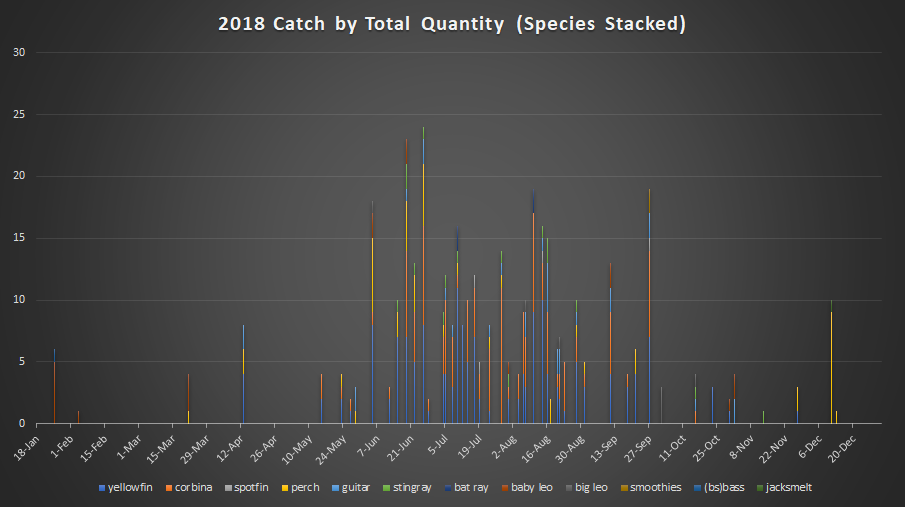
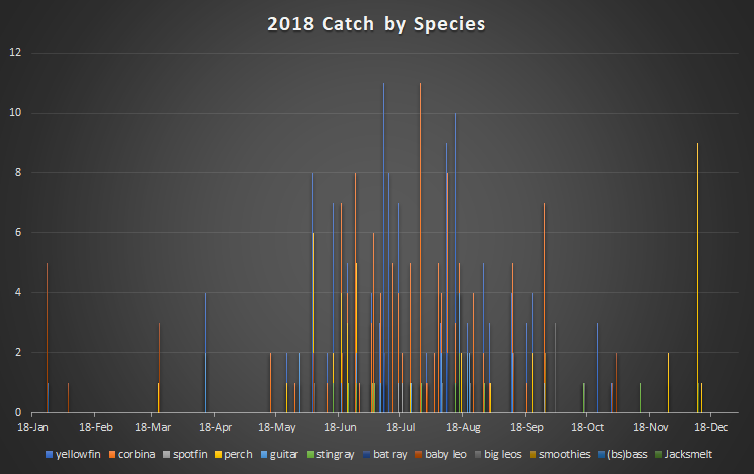
In 2019, the season appeared to begin slightly earlier in mid-May and ended in late September.
The two charts below are from 2019 and show (first) the total number of fish caught per any given session and (second) the number of catches per species per session.
In 2019, it appears the season began slightly earlier (in mid-May) and ended somewhere between October and November. It’s tough to tell as I did not fish as many days this year. Additionally, it’s worth noting that the Winter Perch season was pretty solid too.


Best Time of Year for Yellowfin Croaker Fishing
Here, we see that in 2018, the best time of year for Yellowfin Croaker fishing began the first week of June and ended close to the end of September. In 2019, Yellows seemed to be biting as early as May and the summertime bite didn’t die down until the end of September. All in all, 2018 held many more Yellowfin Croaker than 2019.
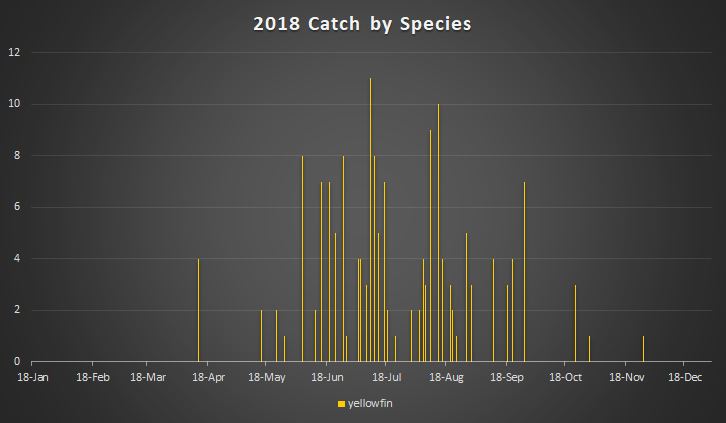
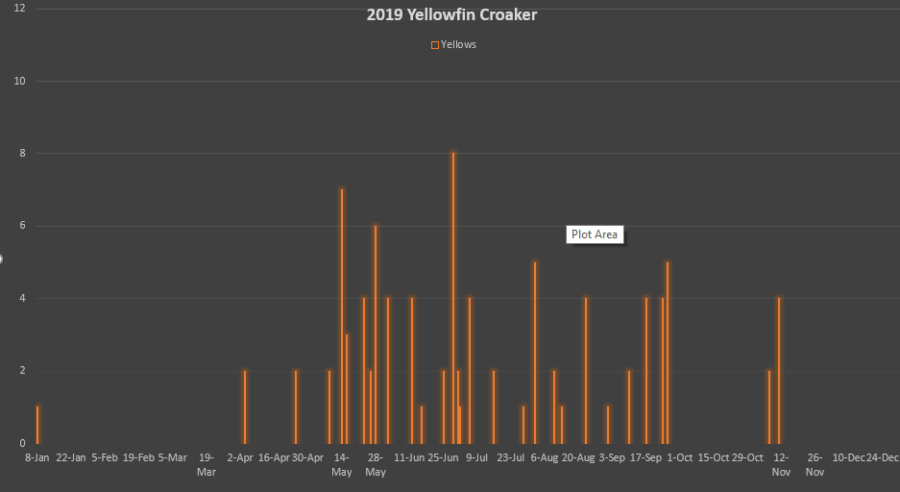
California Corbina Fishing: Best Time of Year
This chart shows that fishing for California Corbina in 2018 didn’t pick up until mid-June and fizzled out as October rolled around. In 2019, a near-identical pattern in timing was presented. While I did not fish as much in 2019 as I did in 2018, the pattern is clearly similar. The best time of year for surf fishing for corbina was between mid-may to mid-September.
One very notable trend though, was that I caught many more Corbina then I did yellowfin Croaker. Similarly, I caught more Corbina than I ever had. The middle spike in the 2019 chart for Corbina represents a day in which I caught 21 Corbina in one session! That same day, my buddy caught somewhere around 25 Corbina!
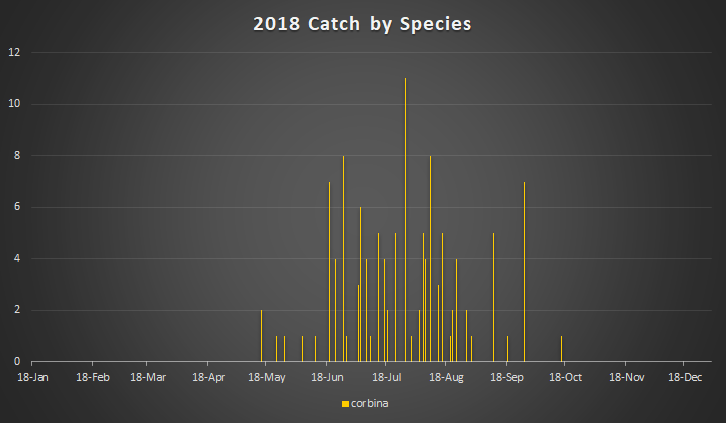

Gear and Tackle
I also want to give you guys the opportunity to see what exactly I use (gear and tackle) to have the success that I have. Per usual, if you have any questions about the gear that I use, feel free to reach out or drop a question in the comments.
Light Tackle Gear
- Rod: Okuma Celilo (8’6″ MA) or the Okuma SST (8’6″ MA)
- Reel: Penn Battle II or III 4000 series
- Mainline: 15-pound monofilament
- For Bait: Carolina Rig:
- Leader Line: 15-pound fluorocarbon
- Swivels: 15-19mm barrel swivels
- Hooks: size #2 or #4 owner mosquito hooks
- Weights: 1-oz egg weight
- Beads: 8mm fishing beads
Swim Bait Gear
- Rod: Okuma SST-S-902HA – 1/2-2oz | 10-30lb | 9ft | H | MF
- Reel: Penn Spinfisher VI (3500 or 4500)
- Main Line: 30-pound braid
- Leader Line: 30-pound mono
- Lure Options:
Jerk Bait Gear
- Rod: Okuma SST (8’6″ MHA)
- Reel: Penn Battle II or III 4000 series
- Main Line:
- Leader Line: 15-pound fluorocarbon
- Lures: Lucky Craft FM 110 and Shimano WM 115 SP
Shark Gear
- Rod: Fiblink Moonsniper (12 or 13 feet)
- Reel: Penn Battle 8000 (II or III)
- Main Line: 50-pound braid
- Topshot: 100-pound nylon coated mono
- Leaders: Shark Leaders
- Weights: 8-ounce pyramid or 6-ounce sputnik
Overall Take, 2025 and Beyond
Keep in mind that the statistics presented here are solely representing my fishing activity. While this can provide a very accurate representation of what fish are out there, and what fish are biting, it only truly shows what “I” tended to catch rather than what all fishermen across So Cal caught.
If you’ve been out surf fishing in the past week or so, you’ve likely had little success with slower than usual fishing – let me know in the comments if you agree or disagree. Taking a look at these charts, my bet is that we’re in for at least one more solid couple weeks of a really good bite before the end of September. Whether it comes with the next heatwave or after the next upwelling is for time to tell.
If you enjoy the content here in this article, be sure to enter your email in the box below and hit subscribe. You’ll receive an email every Sunday when the newest surf fishing report or informational article has been published. Tight Lines!
What beaches are best for surf fishing in San Diego? I went to South Mission beach this last Sunday and there was a lot of sea grass and a good surge. What is the time to go fishing? Thanks for your help! Silvester DeLuca 619-448-5936.
Refer to this: http://surffishingsocalsd.com/best-surf-fishing-spots-in-san-diego/
As for the times, I like sunset and sunrise but all day is good.
Caught a nice Corbina on my fly rod this morning, great fight, 20″
Very nice!
This is my first year of really getting into surf fishing (coming from more freshwater). The bite for me has been much slower over the past couple weeks than it has all summer so far.
Agreed. It should spark back on soon.
I’ve had a tough year. Spots in Encinitas that I’ve had success at have been pretty dead. I want to give it a shot this evening but can’t decide where to try
If you’re near Encinitas and need a bit more sand for this evenings tides, give Solana beach a try. There’s lots of sand there.
Pretty good bite at TP on Sat, but all small. 5 beans in 9-12 inch range, small perch, small yellowfin, and then a big guitar. Very hard to find sand crabs, maybe it was the mid level tide? Ended up stacking 3-4 small ones on a hook at a time.
Thanks for the report! Yah I’ve been getting mostly Surfperch over the last week and a half so hopefully we start seeing more big Corbina and Spotfin again shortly.
For good size sand crabs and lots of them head to the south mission beach jetty just after dark. I collect my crabs there in about 5 minutes after the evening session.
Thanks for the intel!
I have went to S MB and jetty last 2 weeks as well as TP (near lagoon inlet)this morning.. I caught a couple Perch at MB, but the week 0. No one was catching. At TP, a 0 and again no one hooked up. I used SC, but I saw many trying lures. Hopefully it picks up next week.
Thanks for the report! Hoping the same.
Lost my Battle 3 and Fiblink Moonsniper holder as it got pulled into the surf by something big 🙁 faulty rod holder I guess. What rod holders do you use Nick?
Oh my! I actually make my own out of fence posts and pvc. I use a 3 or 4 foot green fence post from Home Depot (the lightweight ones) and then I use a band clamp to secure the pipe to the fence post near the top of the fence post and pvc and then at the bottom of the pvc (only about an 18 inch piece of pvc) I drill a hole in it and run a bolt through it and secure it with a washer.